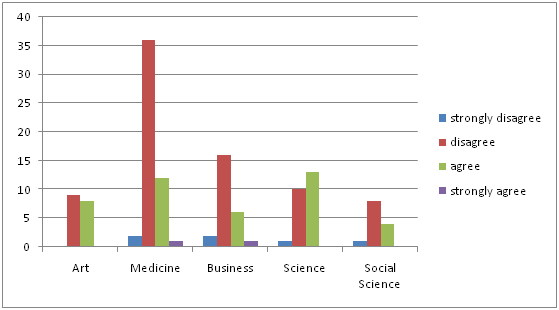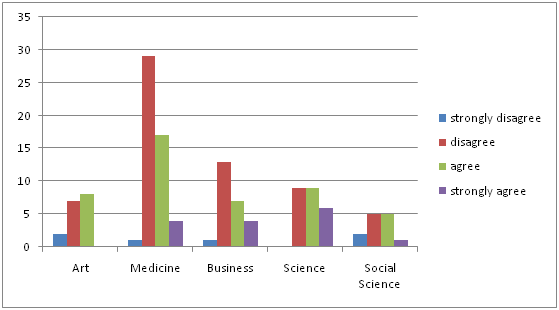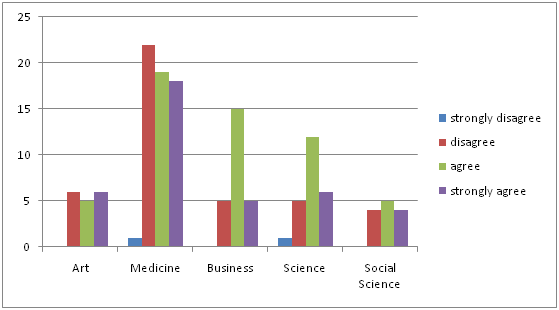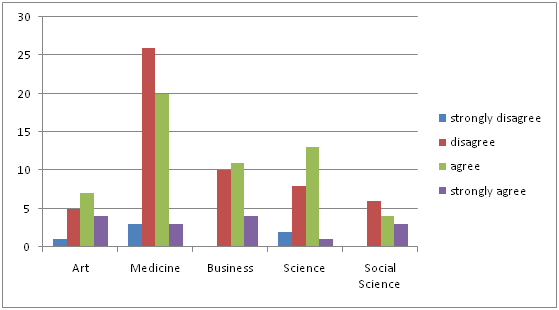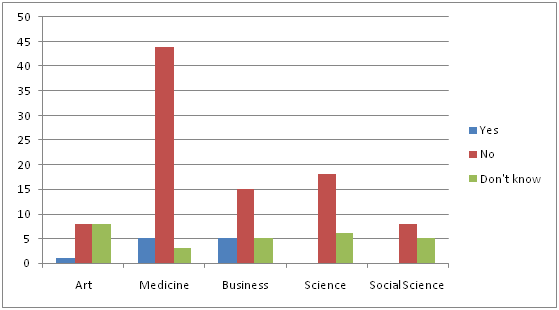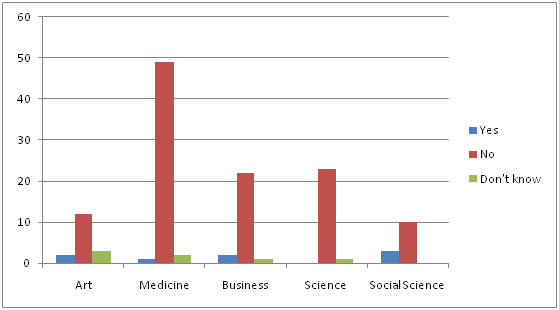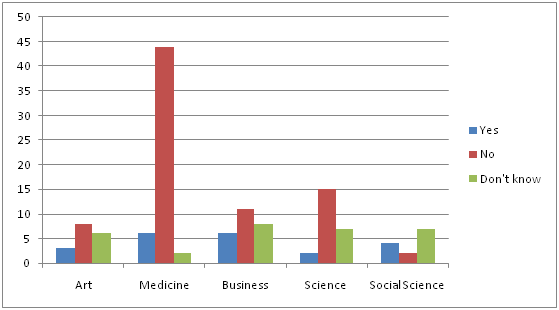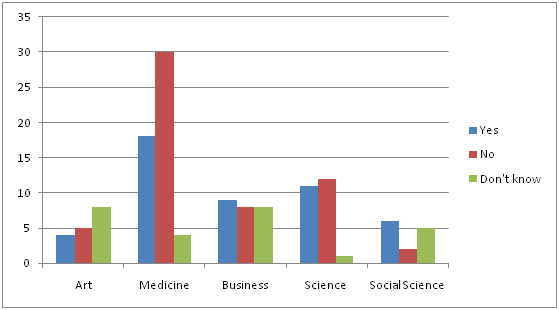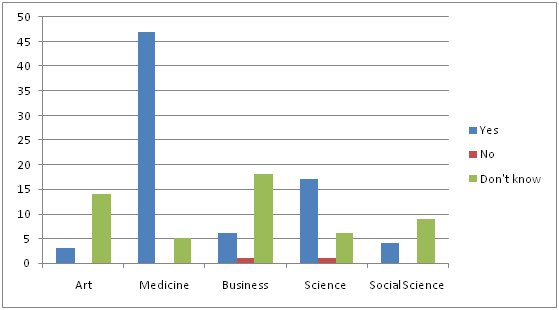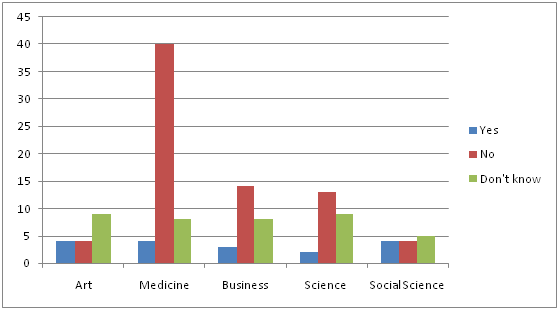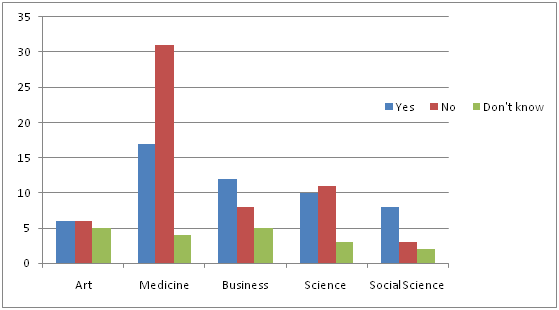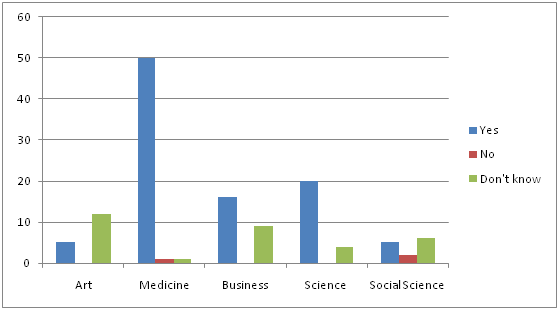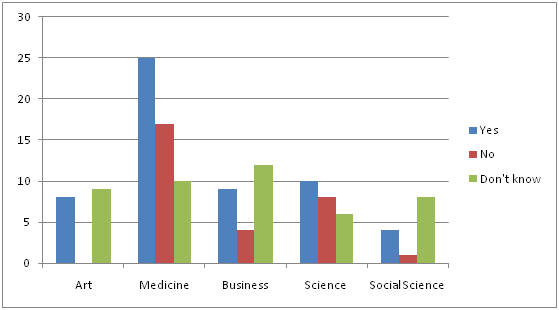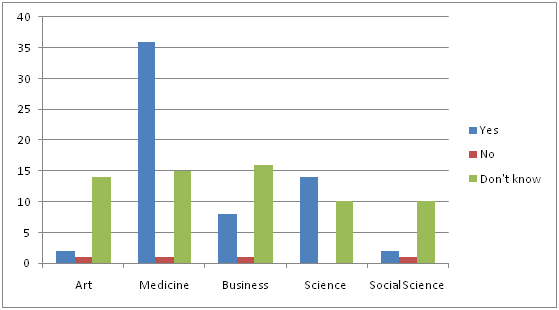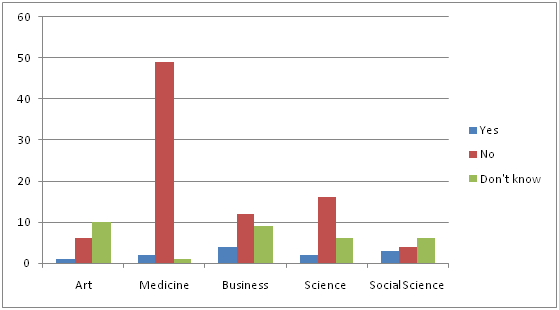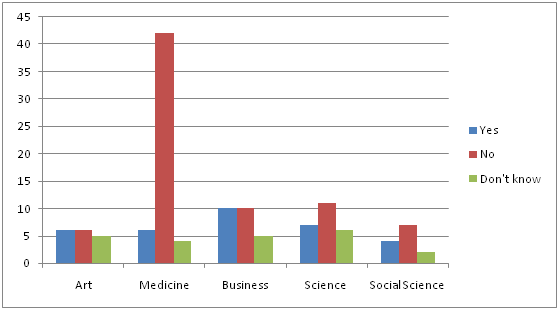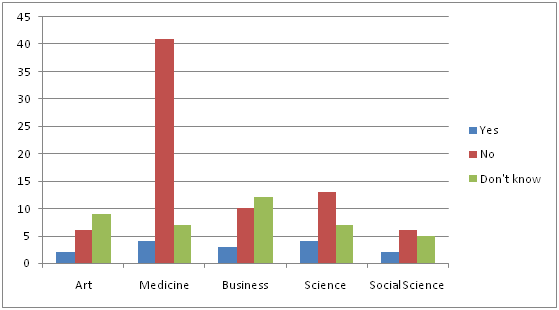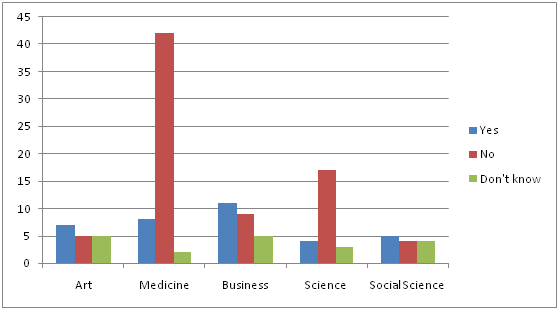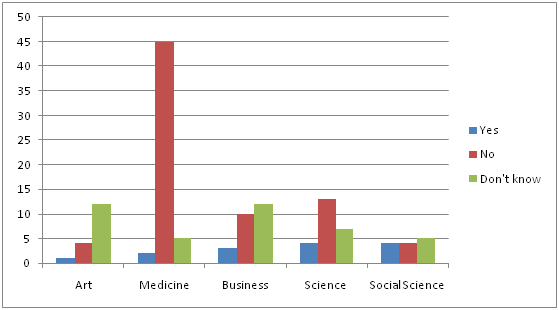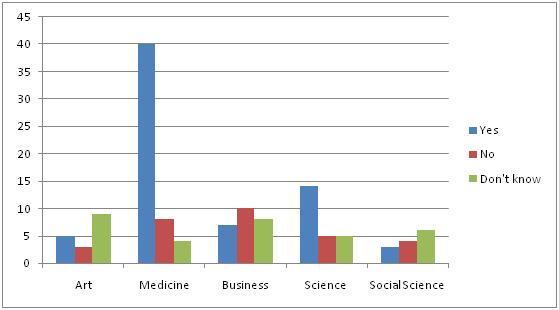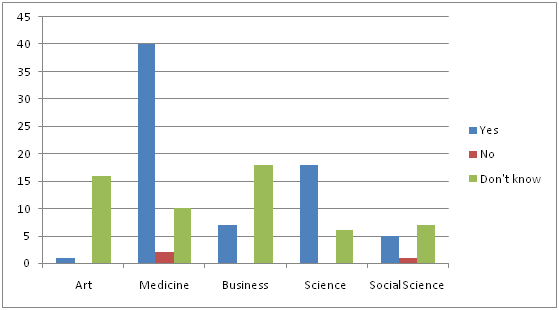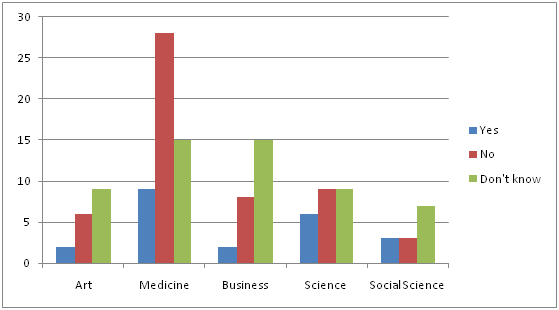Team:HKU-HKBU/Human Practice Questionnaire
From 2009.igem.org
Division for Human Practices Advance - Findings
Overview of results
After receiving all the entries, data analysis were performed. Of all 160 students, the number of students from 5 faculties of study have enough sample size for analysis. They are: 24 science students, 50 medical students, 17 art students, 25 business students and 13 social science students. The answers to each question were analyzed and compared among different faculties.
- In contrast with students from other faculties, the majority of science students agree that Genetically Modified food is harmful.
- In contrast with students from other faculties, the majority of science students agree that genetically modified organisms should be retained in the laboratory setting and should never be released into the wild.
- The majority of all students agree that manipulating, inflicting trauma or killing primates (e.g. monkeys) for experimental purpose is morally wrong.
- In contrast with students from other faculties, the majority of medical students disagree that manipulating, inflicting trauma or killing mouse/guinea pig for experimental purpose is morally wrong.
- Concepts that are well known to non-science, non medical students
- Concepts not well known to non-science, non-medical students
- DNA only exists in the nuclei of cells?
- One of the ways to introduce genes into a bacterium is to introduce a plasmid into it?
- All bacteria are capable of locomotion?
- Gene therapy has already been widely used in modern medicine?
- DNA is made up of 4 types of bases: adenine (A), guanine (G), thymine (T) and cytosine (C)?
- RNA can be genetically inheritable?
- Green florescent protein allows the identification of protein expression?
- Cells communicate with each other by electrical signals only?
- Normal human cells have unlimited replication potential?
- Bacteria cannot exchange their genes among themselves?
- All mutations in DNA have effect(s) on the cell?
- Viruses replicate outside the cells?
- The function of genes is to manufacture proteins?
- In synthetic biology, the most commonly used organism is Escherichia coli?
- Concepts not well known to all students
Figures
In contrast with students from other faculties, the majority of science students agree that Genetically Modified food is harmful.
Genetically modified food is harmful to the human body.
Discussion:
The majority of science students question the safety of genetically modified food, while the majority of students from other faculties do not. In contrast, the majority of medical students (i.e. future health care professionals) do not. We could not think of a satisfactory explanation for this.
In contrast with students from other faculties, the majority of science students agree that genetically modified organisms should be retained in the laboratory setting and should never be released into the wild.
Genetically modified organisms should be retained in the laboratory setting and should never be released into the wild.
Discussion:
The majority of science students are aware that releasing GM organisms into the wild may disturb the natural gene pool of the organism, which may then lead to ecological consequences. Students from other faculties are less aware of the consequences.
The majority of all students agree that manipulating, inflicting trauma or killing primates (e.g. monkeys) for experimental purpose is morally wrong.
Manipulating, inflicting trauma or killing primates (e.g. monkeys) for experimental purpose is morally wrong.
Discussion:
Primates are animals who resemble human beings the most, and in fact a lot of experiment has been done on primates (with or without inflicting trauma) for the sake of understanding human sciences, especially psychology. The majority of university students in Hong Kong, even science students, may be aware of the fact that primates look like human beings, and this resemblance makes them “more humane”, to the extent that they should be respected.
In contrast with students from other faculties, the majority of medical students disagree that manipulating, inflicting trauma or killing mouse/guinea pig for experimental purpose is morally wrong.
Manipulating, inflicting trauma or killing mice/guinea pigs for experimental purpose is morally wrong.
Discussion:
The majority of medical students think that manipulating, inflicting trauma or killing mouse/guinea pig for experimental purpose is not morally wrong. Is it possible that they are aware of the fact that mouse/guinea pig are used in many pre-clinical trials of drugs, and without doing so, clinical drugs trials (i.e. on humans) cannot proceed? That indicates manipulating, inflicting trauma or killing mice/guinea pig for drug development is morally acceptable, since this saves human lives.
Cell types are interchangeable, e.g. muscle cells can become blood cells?
Cell types are interchangeable, e.g. muscle cells can become blood cells.
Discussion:
The majority of students hold the belief that cell types are not interchangeable, which is in general correct until now. However, since the discovery of induced pluripotent stem cells (iPS), it may be possible in the future that different cell types can be inter-converted through the induction of pluripotency, although lots of researches have to be conducted in order for a conclusion to be made. As a general rule of science, theories may not hold true forever.
A pitfall in interpreting the results is that those who chose “yes” may not actually know about induced pluripotent stem cells.
If the parent of a child has an inherited disease, the child would have the same disease?
If the parent of a child has an inherited disease, the child would have the same disease.
Discussion: This statement is false. For a child having one parent affected by an inherited disease:
- For autosomal/X-linked dominant disorders with one affected parent, only 50% of the children will be affected.
- For autosomal recessive disorders, both parents are carriers of the disease.
- For X-linked recessive disorders, only half of the male children will be affected, and half of the female will become carriers.
- For Y-linked disorders, only male children are affected.
- For mitochondrial diseases, only females can pass on the disease but not the males.
- For polygenic disorders, there is no clear-cut pattern of inheritance.
All infectious substances are living things?
All infectious substances are living things.
Discussion:
The majority of students answered “No” to this question. However, it is unclear whether they think that viruses are non-living (which is controversial), or actually they think about prions which is definitely non-living proteins.
DNA only exists in the nuclei of cells?
DNA only exists in the nucleus of cells - False
Discussion:
Art, business and social science students are probably unaware of the distinction between prokaryotic and eukaryotic cells. For prokaryotic cells (e.g. bacterial cells), they are no nuclei. For eukaryotic cells, DNA does not only exist in nuclei, but also in the mitochondria as mitochondrial DNA.
One of the ways to introduce genes into a bacterium is to introduce a plasmid into it?
One of the ways to introduce genes into a bacterium is to introduce a plasmid into it - True
Discussion:
Art, business and social science are not familiar with the term “plasmid”, which is essential in synthetic biology.
All bacteria are capable of locomotion?
All bacteria are capable of locomotion-False
Gene therapy has already been widely used in modern medicine?
Gene therapy has already been widely used in modern medicine - False
Discussion:
Gene therapy has been successful in some situations, but it has not yet gone into mainstream medicine. Further advances are needed in order to prove its efficacy in the myriad of diseases.
DNA is made up of 4 types of bases: adenine (A), guanine (G), thymine (T) and cytosine?
DNA is made up of 4 types of bases: adenine (A), guanine (G), thymine (T) and cytosine (C) - True
Discussion:
Without understanding the base pairs of DNA, we would never understand how DNA encodes genetic information. From the result of this questionnaire, we can see that the majority of laypeople do not understanding how DNA works.
RNA can be genetically inheritable?
RNA can be genetically inheritable - True
Discussion:
Art, business and social science students probably can choose the right answer if the question becomes “DNA is genetically inheritable”. However, when it comes to RNA, many of them choose “I don’t know”. They are unaware of the presence of RNA viruses.
Green florescent protein allows the identification of protein expression?
Green florescent protein allows the identification of protein expression - True
Discussion:
The role of Green Florescent Protein as a reporter of expression is largely unknown to art, business and social science students. It is possible that they have not heard about this protein, or they may not know the term “protein expression”, or both.
Cells communicate with each other by electrical signals only?
Cells communicate with each other by electrical signals only - False
Discussion:
Cells also communicate with each other by chemical signals, e.g. hormones, through ligand-receptor interaction.
Normal human cells have unlimited replication potential?
Normal human cells have unlimited replication potential - False
Discussion:
It is possible that some students answered “yes” because they think that normal equals healthy and for healthy cells they must have the ability to replicate. This is an oversimplified view.
Bacteria cannot exchange their genes among themselves?
Bacteria cannot exchange their genes among themselves - False
Discussion
The majority of art, business and social science students do not know about bacterial conjugation, which is an important concept within the realm of synthetic biology and genetic engineering.
All mutations in DNA have effect(s) on the cell?
All mutations in DNA have effect(s) on the cell - False
Discussion:
This shows that art, business and social science students have an oversimplified view of DNA mutation, without knowing the fact that some mutations are neutral under certain conditions.
Viruses replicate outside the cells?
Virus replicate outside the cells - False
Discussion:
The majority of art, business and social science students do not know where viruses replicate. As a result, it is possible that they do not know that virus can be manipulated to carry genes into cells.
The function of genes is to manufacture proteins?
The function of genes is to manufacture proteins - True
Discussion:
Actually, the function of genes is to manufacture proteins and RNAs (e.g. to manufacture the RNA in ribosomes). Quite a significant proportion of “Don’t know” answers were received from art, business and social science students. We postulate that laypeople actually do know that genes affect the functioning of the body, without knowing what causes this function: proteins and RNA.
In synthetic biology, the most commonly used organism is Escherichia coli?
In synthetic biology, the most commonly used organism is Escherichia coli - True
Discussion:
It is possible that many art, business or social science students do not know about E. coli besides not knowing that it is the most commonly used organism in synthetic biology.
Up to this moment, scientists have successfully synthesized an organism from molecules?
Up to this moment, scientists have successfully synthesized an organism from molecules - True
Discussion:
In 2003, it was reported that the whole genome of the bacteriophage phi X 174 had been assembled synthetically from scratch and fully infectious X174 virions were recovered after electroporation into Escherichia coli. The majority of all students do not know about this.
 "
"

